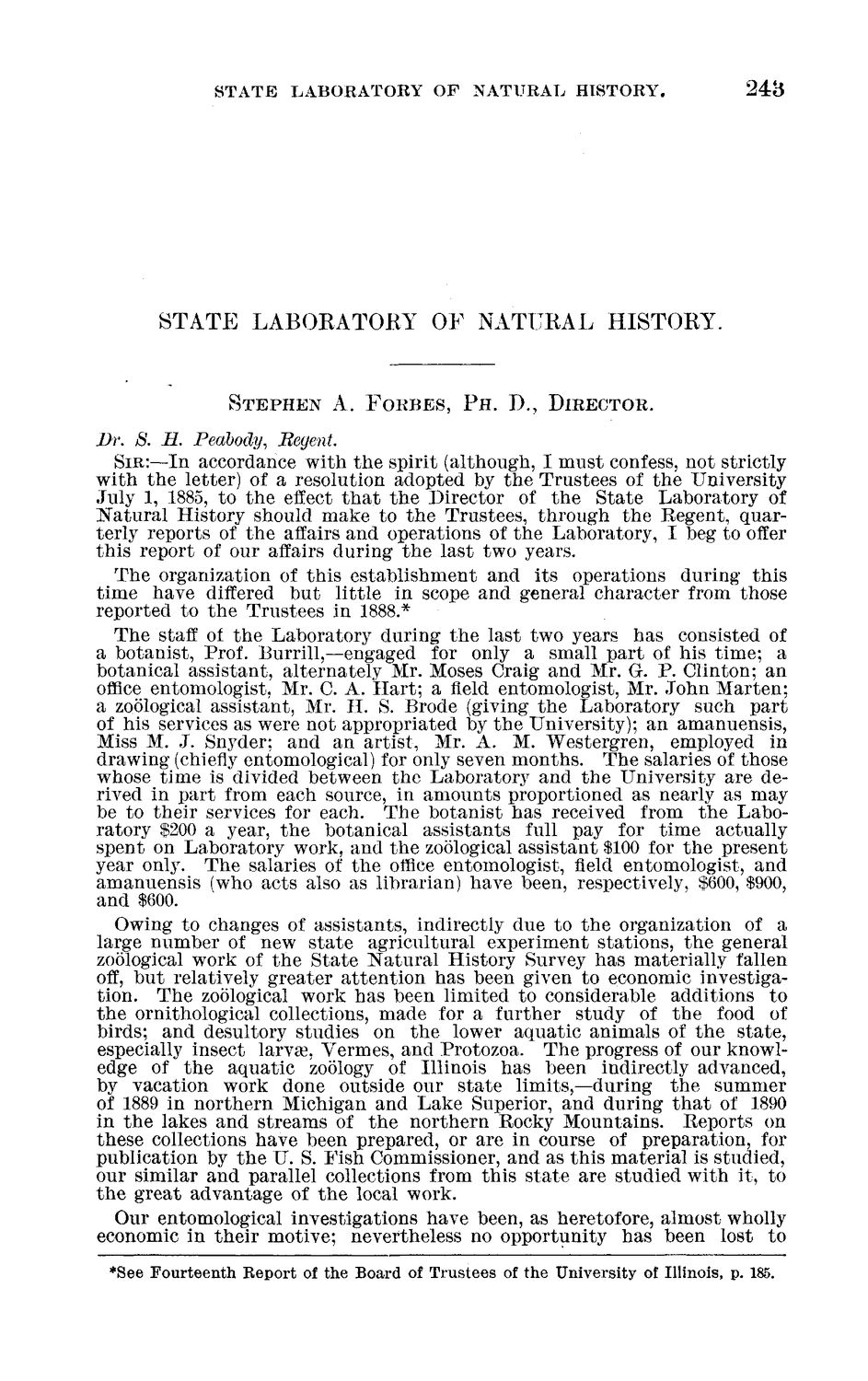| |
| |
Caption: Board of Trustees Minutes - 1890
This is a reduced-resolution page image for fast online browsing.

EXTRACTED TEXT FROM PAGE:
STATE LABORATOBY OF NATURAL HISTORY. 248 STATE LABORATORY OF NATURAL HISTORY. STEPHEN A. FORBES, PH. D., DIRECTOR. Dr. S. H. Peabody, Begent. SIR:—In accordance with the spirit (although, I must confess, not strictly with the letter) of a resolution adopted by the Trustees of the University July 1, 1885, to the effect t h a t the Director of the State Laboratory of Natural History should make to the Trustees, through the Regent, quarterly reports of the affairs and operations of the Laboratory, I beg to offer this report of our affairs during the last two years. The organization of this establishment and its operations during this time have differed but little in scope and general character from those reported to the Trustees in 1888.* The staff of the Laboratory during the last two years has consisted of a botanist, Prof. Burrill,—engaged for only a small part of his time; a botanical assistant, alternately Mr. Moses Craig and Mr. G. P. Clinton; an office entomologist, Mr. C. A. Hart; a field entomologist, Mr. John Marten; a zoological assistant, Mr. H. S. Brode (giving the Laboratory such part of his services as were not appropriated by the University); an amanuensis, Miss M. J. Snyder; and an artist, Mr. A. M. Westergren, employed in drawing (chiefly entomological) for only seven months. The salaries of those whose time is divided between the Laboratory and the University are derived in part from each source, in amounts proportioned as nearly as may be to their services for each. The botanist has received from the Laboratory $200 a year, the botanical assistants full pay for time actually spent on Laboratory work, and the zoological assistant $100 for the present year only. The salaries of the office entomologist, field entomologist, and amanuensis (who acts also as librarian) have been, respectively, $600, $900, and $600. Owing to changes of assistants, indirectly due to the organization of a large number of new state agricultural experiment stations, the general zoological work of the State Natural History Survey has materially fallen off, but relatively greater attention has been given to economic investigation. The zoological work has been limited to considerable additions to the ornithological collections, made for a further study of the food of birds; and desultory studies on the lower aquatic animals of the state, especially insect larva?, Vermes, and Protozoa. The progress of our knowledge of the aquatic zoology of Illinois has been indirectly advanced, by vacation work done outside our state limits,—during the summer of 1889 in northern Michigan and Lake Superior, and during t h a t of 1890 in the lakes and streams of the northern Rocky Mountains. Reports on these collections have been prepared, or are in course of preparation, for publication by the U. S. Fish Commissioner, and as this material is studied, our similar and parallel collections from this state are studied with it, to the great advantage of the local work. Our entomological investigations have been, as heretofore, almost wholly economic in their motive; nevertheless no opportunity has been lost to •See Fourteenth Report of the Board of Trustees of the University of Illinois, p. 185.
| |